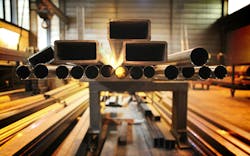New manufacturing processes can make steel construction a greener option and add U.S. jobs
By Peter Fabris, Contributing Editor
“Green steel” that is manufactured using hydrogen generated with renewable energy makes its use as a building material more feasible for environmentally conscious designers and clients.
Sustainable manufacturing processes, which are economically viable in the U.S., could also revive steelmaking in the country as the metal becomes more attractive for green building. In addition, faster adoption of green steel could be fueled by communities competing for new plants and the new jobs that come with them, making them more attractive to build for steel manufacturing companies.
“A transition to fossil fuel-free steelmaking could grow total jobs supported by steelmaking in the region by 27% to 43% by 2031, forestalling projected job losses,” according to a study by the Ohio River Valley Institute. “Regional jobs supported by traditional steelmaking are expected to fall by 30% in the same period.”
The traditional steelmaking process using coal generates 7.2% of all carbon emissions worldwide, making the industry alone more polluting than the entire European Union, according to one estimate.
A modern, greener method of producing steel works like this: Iron ore is melted in an electric arc furnace using hydrogen, rather than coke, to process the material. This requires less energy than traditional methods, and renewable energy could power the furnace and generate hydrogen, making the process environmentally sound.
Developmental projects in Europe are experimenting with biochar, electrolysis, and other ways to power the electric arc process. In the U.S., one company is experimenting with an oxide electrolysis model that eliminates the need for coal by creating a chemical reaction that turns iron ore into steel.
Any of these greener steelmaking methods could help make the metal a sound choice for meeting sustainability standards and goals.
